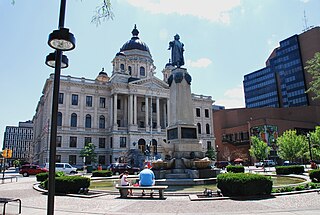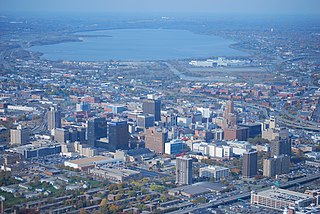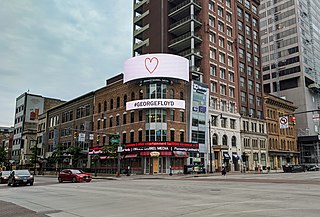
Syracuse is a city in and the county seat of Onondaga County, New York, United States. It is the fifth-most populous city in the state of New York following New York City, Buffalo, Yonkers, and Rochester.

Downtown Syracuse is the economic center of Syracuse, New York, and Central New York, employing over 30,000 people, and housing over 4,300.

The Sweet Auburn Historic District is a historic African-American neighborhood along and surrounding Auburn Avenue, east of downtown Atlanta, Georgia, United States. The name Sweet Auburn was coined by John Wesley Dobbs, referring to the "richest Negro street in the world," one of the largest concentrations of African-American businesses in the United States.

Harriet Tubman National Historical Park is a US historical park in Auburn and Fleming, New York, associated with the life of Harriet Tubman. It comprises three properties: the Harriet Tubman Home for the Aged, in Auburn; the nearby Harriet Tubman Residence ; and the Thompson A.M.E. Zion Church in Auburn. They are located at 180 and 182 South Street, and 90 Franklin Street, respectively. The Zion Church unit is administered by the National Park Service (NPS), while the South Street properties, including a historic barn and a visitor center, are jointly managed and operated by both the NPS and the Harriet Tubman Home, Inc. The church also works with the NPS in park operations. The Harriet Tubman Grave in nearby Fort Hill Cemetery is not part of the park.

The Gridley Building, built in 1867 and known previously as the Onondaga County Savings Bank Building, is a prominent historic building on Clinton Square and Hanover Square in Syracuse, New York, United States. It was designed by Horatio Nelson White and was built adjacent to what was then the Erie Canal and is now Erie Boulevard.

St. Paul's Cathedral in Syracuse, New York was designed by Henry Dudley, who worked with Frank Wills until Wills' early death in 1857.
Henry C. Dudley (1813–1894), known also as Henry Dudley, was an English-born North American architect, known for his Gothic Revival churches. He was a founding member of the American Institute of Architects and designed a large number of churches, among them Saint Paul's Episcopal Cathedral in Syracuse, New York, built in 1884, and Trinity Church, completed in 1858.

Archimedes Russell was an American architect most active in the Syracuse, New York area.

Grace Episcopal Church is an historic Episcopal parish in Syracuse, New York. The Gothic Revival building was designed by Horatio Nelson White and was built in 1876. It is located at 819 Madison Avenue near Syracuse University. On March 20, 1973, it was listed on the National Register of Historic Places.

The Hamilton White House is a historic home in Syracuse, New York. The house, Greek Revival in design, was built by and for Hamilton White, circa 1840/42, and occupied by his family in 1842/43. Many believe based on similarities in structure and style that the unknown architect and builder was the same person who designed and built the Moses Burnett House, completed in early 1842, later to become the Syracuse Century Club building. The house was added to the National Register of Historic Places in 1973 due to its significance in the area of architecture and its relationship, through Hamilton White, to the commerce and politics of Syracuse.
The National Register of Historic Places listings in Syracuse, New York are described below. There are 111 listed properties and districts in the city of Syracuse, including 19 business or public buildings, 13 historic districts, 6 churches, four school or university buildings, three parks, six apartment buildings, and 43 houses. Twenty-nine of the listed houses were designed by architect Ward Wellington Ward; 25 of these were listed as a group in 1996.

The Central Troy Historic District is an irregularly shaped, 96-acre (39 ha) area of downtown Troy, New York, United States. It has been described as "one of the most perfectly preserved 19th-century downtowns in the [country]" with nearly 700 properties in a variety of architectural styles from the early 19th to mid-20th centuries. These include most of Russell Sage College, one of two privately owned urban parks in New York, and two National Historic Landmarks. Visitors ranging from the Duke de la Rochefoucauld to Philip Johnson have praised aspects of it. Martin Scorsese used parts of downtown Troy as a stand-in for 19th-century Manhattan in The Age of Innocence.

There are 75 properties listed on the National Register of Historic Places in Albany, New York, United States. Six are additionally designated as National Historic Landmarks (NHLs), the most of any city in the state after New York City. Another 14 are historic districts, for which 20 of the listings are also contributing properties. Two properties, both buildings, that had been listed in the past but have since been demolished have been delisted; one building that is also no longer extant remains listed.

The St. Peter's Episcopal Church Complex is a historic Episcopal church complex located at 169 Genesee Street in Auburn. The complex consists of the church, the Parish House, a cemetery, and a small burial plot.

Robert W. Gibson, AIA, was an English-born American ecclesiastical architect active in late-nineteenth- and early-twentieth-century New York state. He designed several large Manhattan churches and a number of prominent residences and institutional buildings.

South Salina Street Downtown Historic District is a historic district representing what was the commercial core of in Syracuse, New York from the mid-nineteenth century to the mid-twentieth century. It was listed on the National Register of Historic Places on October 16, 2009. The vacancy rate in the district is high, and some buildings need extensive rehabilitation. Recent revitalization plans served as impetus for seeking listing on the National Register of Historic Places.
Syracuse is a city in Central New York sited on the former lands of the Onondaga Nation. Officially incorporated as a village in 1825, it has been at a major crossroads over the last two centuries, first of the Erie Canal and its branch canals, then on the railway network. The city grew on the back of its salt and chemical industries, and later as a center of manufacturing and engineering. Although its industries have dwindled, the city has remained the economic and educational hub of Central New York, a region with over a million inhabitants; the population of the city, though, has been in decline since peaking in the 1950s.

People's African Methodist Episcopal Zion Church is a historic African Methodist Episcopal Zion church located in Downtown Syracuse, Onondaga County, New York. It was designed by architect Charles Erastus Colton and Wallace Rayfield and built in 1911. It is a small Gothic Revival style stuccoed brick building. It sits on a cut limestone foundation and measures approximately 25 feet wide and 50 feet deep. It has a two-story projecting front gable and features a three-story bell tower topped by a pyramidal roof. The congregation was incorporated in 1837 and remained at this location until 1976.
Trinity Episcopal Church, now known as the Faith by Love Church, is a historic Episcopal church located in the Southwest / Near Westside neighborhood of Syracuse, Onondaga County, New York. The church was built in 1914–1915, and is a one-story, Collegiate Gothic style stone building. It has a steeply pitched front gable slate roof and a massive square tower with corner buttresses. Also on the property is the contributing Parish House. It is a two-story, Second Empire style frame dwelling with a mansard roof. The Jaynes Memorial Hall was added to the rear of the Parish House in 1926. The congregation was established in 1855, and remained at the location until 1994.

The 100 percent corner is the busiest area in a city. Often it is a crossroads of several major streets, and the place with the highest land value and/or where grid plan numbering is based upon. The term is also used for the place for ideal real estate projects, sometimes considered the intersection of two highways in a suburban area. The terms "hundred percent location", "hundred percent corner", or "peak land value intersection" may also be used.
















